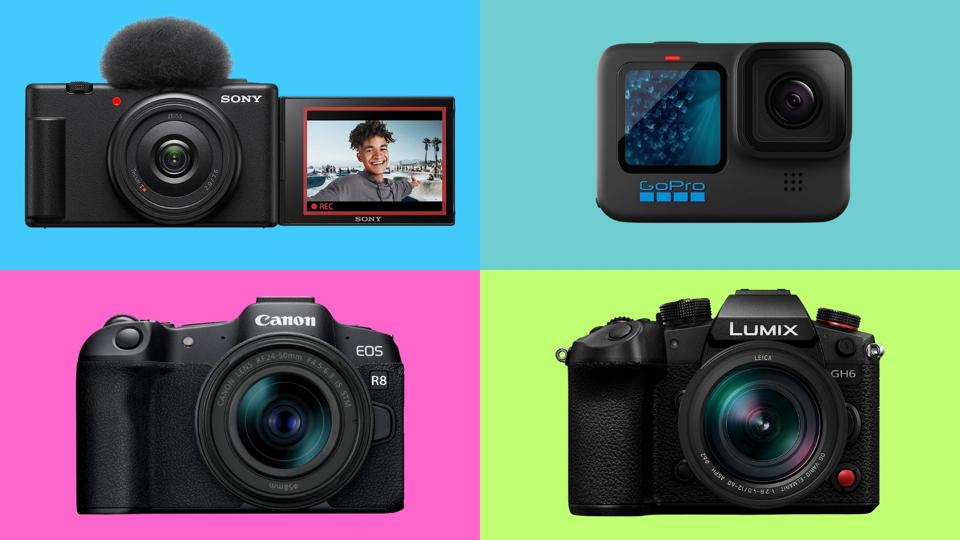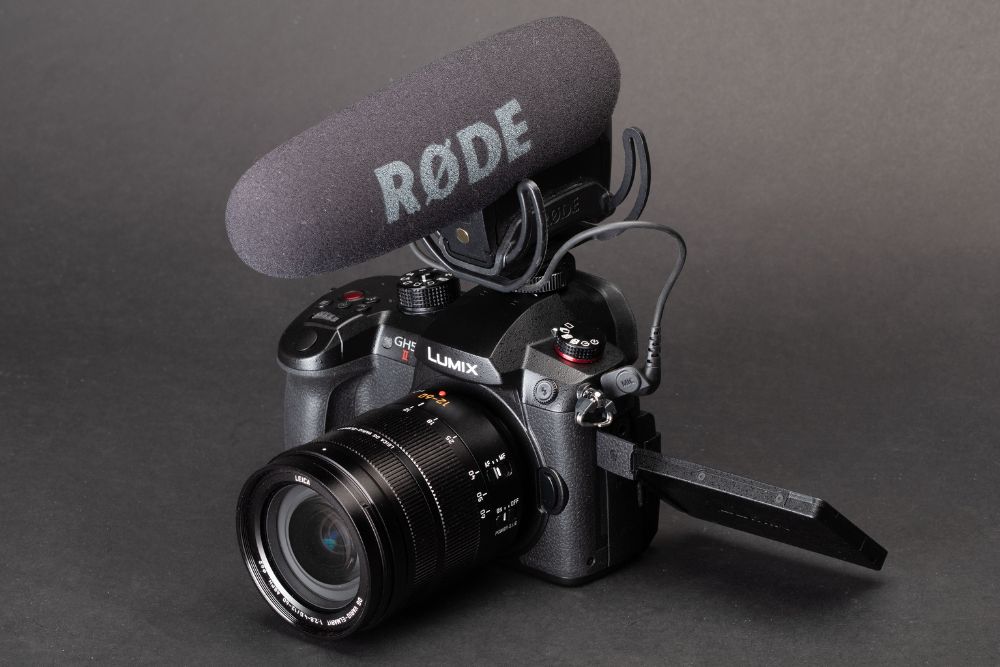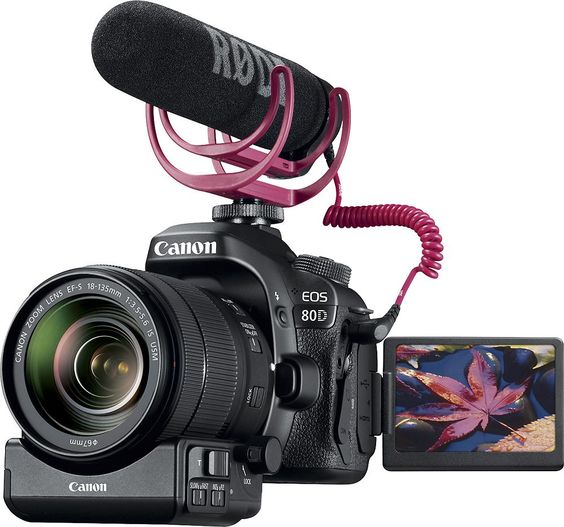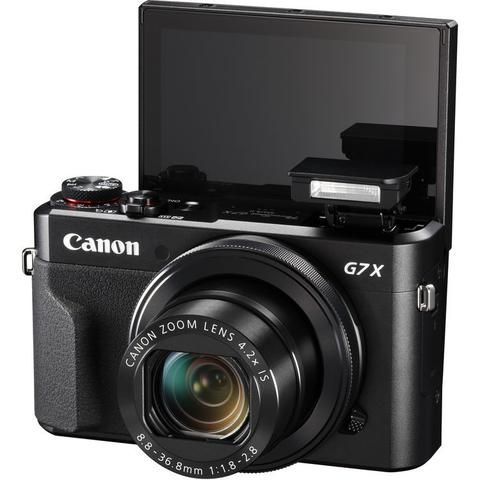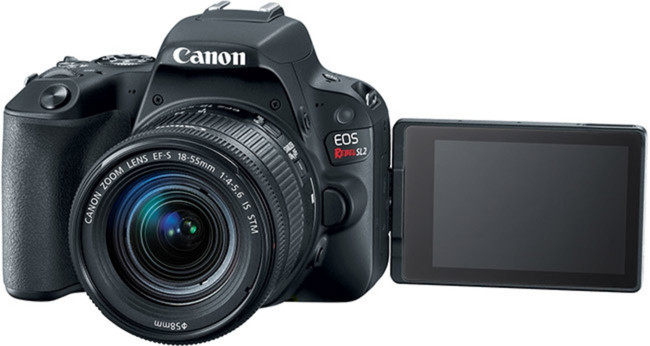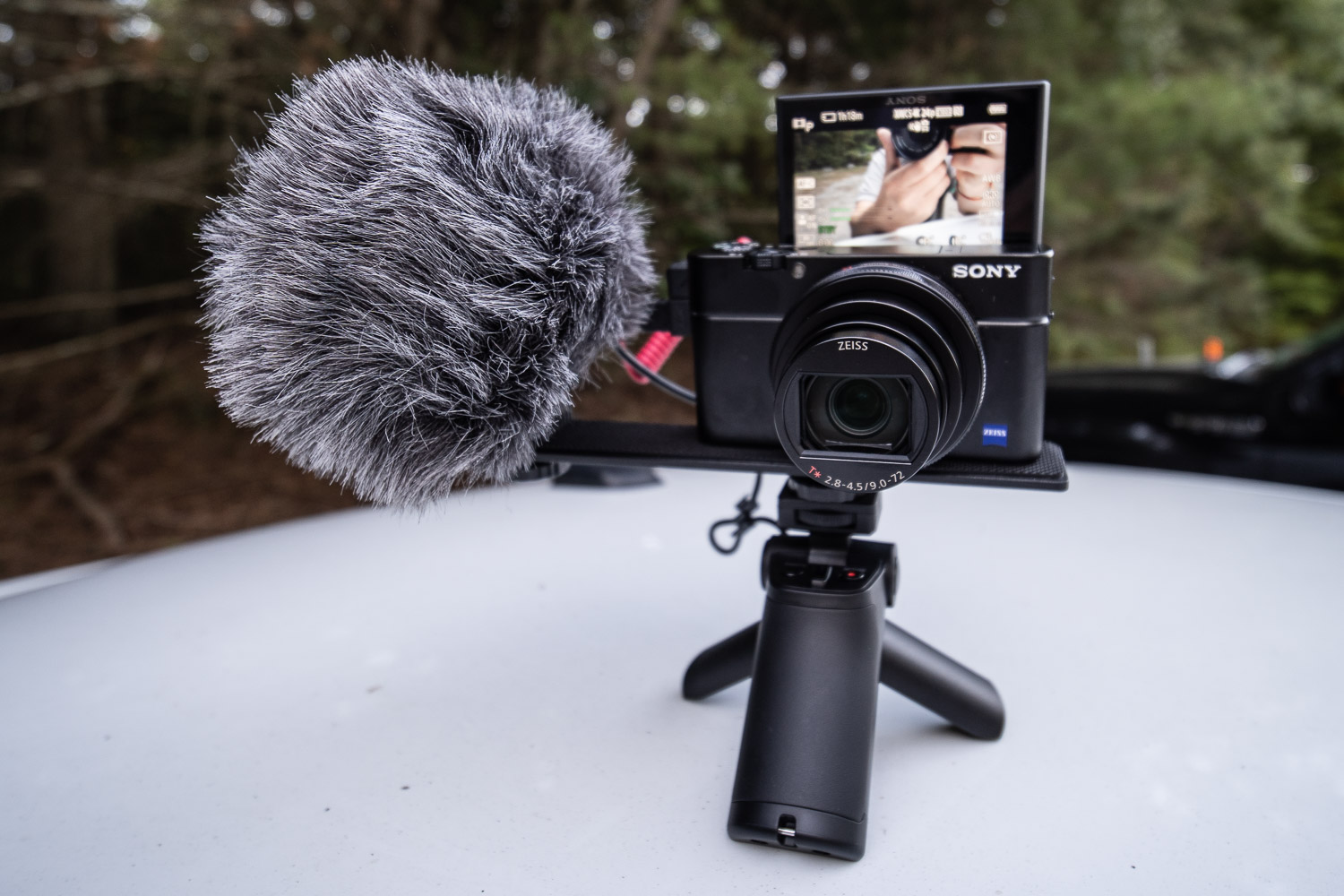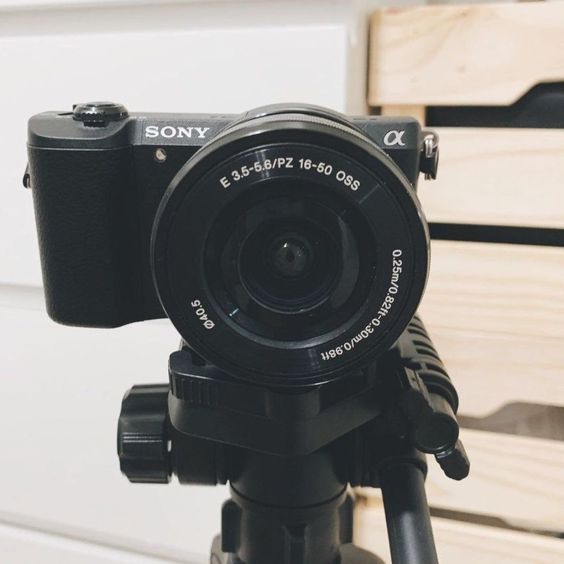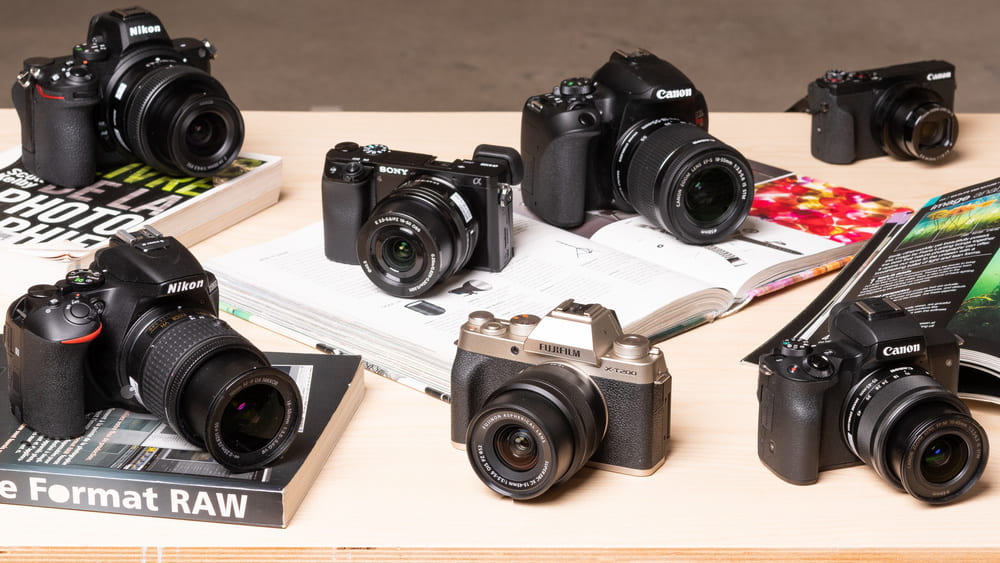The rise in popularity of YouTube vlogs has been nothing short of astounding, and in light of this, I have compiled a post to assist you in selecting the finest camera for vlogging available.
BEST CAMERA FOR VLOGGING
| Type | Camera | Price $ | Details |
|---|---|---|---|
| Overall | Panasonic Lumix GH5 | 1200~1300 | See |
| Compact | Canon G7x Mark II | 700~800 | See |
| Intro | Canon EOS Rebel SL2 | 500~600 | See |
| Outdoor | Sony RX100 Mark IV | 1100~1200 | See |
| Under $1000 | Canon EOS 80D | 500~700 | See |
| Under $500 | Sony a5100 | 400~500 | See |
| Cheapest | Fujifilm S3100 | ~50 | See |
This post delves into the features that can improve your vlogging experience, making it both enjoyable and effortless. It also aims to help you know the essential things to consider when choosing a vlog camera.
This article will ensure that you make the right choice when selecting a camera that meets all your needs. So, without further ado, let’s find out with Tipcameras.com!
The Best Camera for Vlogging: Reviews & Recommedations
Panasonic Lumix GH5 | Best All Round Vlogging Camera
Technical Specifications:
- Image Sensor: 20.3MP Micro Four Thirds CMOS
- Megapixels: 20.3
- Dimensions: 5.45 x 3.86 x 3.44″ (138.5 x 98.1 x 87.4 mm)
- Weight: 645 g (1.42 lbs / 22.72 oz)
|
PROS |
CONS |
|
|
If you’re searching for top-notch cameras for vlogging with 4K video capabilities and DSLR-like user-friendliness, look no more than the incredible Panasonic Lumix GH5 micro four thirds mirrorless camera.
It’s pleasing to witness camera manufacturers focusing on their respective specialties with their flagship devices. For Nikon and Canon, it’s the versatile professional stills camera, while for Panasonic, it’s all about video.
Panasonic has chosen to stick with their proven 20-megapixel micro four thirds sensor with the GH5 – a sensor format that may cause some confusion due to its smaller size. After all, why would anyone invest in a camera with a sensor smaller than APS-C and only around half the size of a full-frame sensor?
While an MFT sensor may never achieve the exceptional performance of larger sensors in low-light conditions, it’s still an excellent choice for regular lighting situations. MFT sensors offer advantages such as smaller, lighter, and more affordable camera bodies and lenses (refer to the best micro four thirds lenses).
The Panasonic Lumix GH5 is by no means a compact, lightweight camera, but it delivers video performance usually associated with much larger devices. Its low-light capabilities may not match that of cameras like the Canon 6D Mark II, but it’s still more than adequate for most vlogging scenarios.
The video quality is outstanding. Shooting in 4K at 60fps produces exceptionally detailed footage, surpassing the quality of typical prosumer-grade cameras.
There are plenty of options for frame rates, resolutions, and bitrates, ensuring even the most dedicated video enthusiasts will be satisfied. You can shoot 4K footage at a cinematic 24fps, utilizing a richer 4:2:2 10-bit color space that offers a broader dynamic range for post-production grading.
Vloggers who enjoy incorporating time lapse footage into their content can take advantage of the in-camera frame rate control, allowing for shooting as low as 2fps.
Capturing footage at a higher frame rate for later slow-motion editing is a popular technique among vloggers. With the Lumix GH5, you can shoot at 180fps in 1080P, resulting in beautifully smooth slow-motion footage.
Two SD memory cards have the capacity to store all data simultaneously. Alternatively, the second card can be configured as an overflow option for when the first one becomes full. Out of all the cameras mentioned in this list, the GH5 is the sole recommendation that offers dual slots for SD cards.
Vloggers in need of thumbnails for their YouTube videos will find the Lumix GH5’s 6K Photo Mode particularly fascinating. This mode allows you to capture video at a rate of 30 frames per second, and later extract any of those frames as an 18-megapixel still image.
Engaging in run-and-gun documentary-style video shooting becomes significantly easier due to the remarkable image stabilization featured in both compatible lenses and the camera body itself. This is, without a doubt, the most exceptional optical image stabilization I have witnessed in a camera within this price range.
Focusing and tracking your face while vlogging is a breeze thanks to the 225-point autofocus system and face-detection technology. Additionally, the fully articulating 3.2-inch flip-out touchscreen is vibrant, detailed, well-designed, and offers a delightful user experience.
When engaging in the creation of first-person video blogs, it is generally recommended to utilize a wide angle lens. This particular lens allows for filming at arm’s length, encompassing not only your visage but also as much of the surrounding environment as possible. Fortunately, the Lumix GH5 possesses remarkable image stabilization capabilities and a face detection auto focus feature, making the process of first-person filming significantly more effortless.
If your intention is to film a scene where you have control over the positioning of your subjects, the Lumix GH5 offers an exceptional feature that enables automatic transitions between pre-set focus points.
It is worth noting that in situations with limited lighting, the performance of the auto focus may encounter challenges. To combat this, it is highly.
Canon EOS 80D | Best Vlogging Camera under $1000
Technical Specifications:
- Image Sensor: 24.2MP APS-C CMOS
- Megapixels: 24.2
- Dimensions: 3.09 x 5.47 x 4.14″ (78.5 x 138.9 x 105.16 mm)
- Weight: 730 g (1.61 lbs / 25.75 oz)
- Canon’s Dual Pixel AF technology
|
PROS |
CONS |
|
|
If you’re in search of Canon cameras for vlogging, the chances are high that you’ve come across the Canon 80D. In all likelihood, you’ve also encountered the Canon 70D and Canon SL2.
To be completely honest, all of these Canon cameras are excellent choices, but let’s delve into why I consider the Canon 80D.
First and foremost, the Canon 80D meets all the essential criteria when it comes to hardware. It features a flip screen with a touch screen interface, built-in wireless capabilities, optical image stabilization, an external microphone port, an external headphone port, and a long battery life.
However, it is worth mentioning that it does have a slightly substantial weight of 730 g (1.6 lbs). While this is not unreasonable for a professional-grade DSLR camera, it may pose some challenges for vloggers who wish to hold it at arm’s length for extended periods.
Also, keep in mind that investing in a Canon DSLR for vlogging opens up the doorway to the marvelous world of Canon lenses. I highly recommend exploring the Power to Create 2-lens kit, which offers a wide-angle zoom and a fast, lightweight prime lens at an incredible price.
Furthermore, you can also take advantage of affordable and lightweight lenses like the exceptional Canon 10-18mm f/4.6-5.6 wide-angle zoom lens – a popular choice among vloggers who use Canon cameras.
The Canon 80D’s industry-leading autofocus is one of the primary reasons why many YouTube vloggers opt for this camera. With 45 sensitive cross-type AF points and Canon’s remarkable Dual Pixel CMOS AF, the camera can swiftly and accurately acquire and lock focus within milliseconds.
The ability to touch the detailed and vibrant 3-inch articulating screen while recording, instantly bringing a subject into focus, is an incredible feature. Moreover, it performs impressively well in low-light situations, with reliable focusing performance down to EV-3.
The practicality of Canon’s Dual Pixel AF technology held little significance for photographers focused on stills, but for videographers and vloggers, it presented a genuine advantage, allowing for effortless cinematic-style focus transitions.
Transitioning between subjects using the Canon 80D is as simple as a touch on the screen, and coupled with the predictive capabilities of Movie Servo AF and the extensive AF point spread, even moving subjects can be seamlessly tracked.
Vlogging often entails filming oneself extensively, and fortunately, the face-tracking auto focus capabilities of the Canon 80D are unrivaled.
The quality of movie imagery is excellent, as one would expect from a Canon camera tailor-made for vlogging.
While the absence of 4K video recording may or may not be problematic for some, the ability to crop your footage during post-production can be advantageous, and the added detail is a nice touch. However, one must consider whether viewers will fully utilize the 4K footage, as most tend to watch content on their mobile phones.
Despite the lack of 4K recording, you can film in full 1920 x 1080 HD at 30 and 24 fps in MOV format, or at 60/30/24 fps in MP4 mode. The inclusion of 60fps recording in 1080p is an excellent new feature, eliminating the need to downgrade to 720p for slow-motion footage.
Other MP4 options include HD (1280 x 720) at 60/30 fps. Additionally, there’s an HDR movie mode (1920 x 1080) at 30 fps and a new time-lapse feature, which was absent in the 70D.
The ability to record directly to MP4 is advantageous when uploading content directly to the web, whereas the MOV format is better suited for maximizing dynamic range, as it offers a higher bitrate and less compression.
If 4K video recording capabilities are an absolute necessity at this price point, the Sony a6500 can be considered, as it provides improved autofocus over the Canon 80D.
However, an important drawback of the Sony a6500 is the lack of a flip screen for self-viewing during recording, which is why it isn’t included in this list of the best vlogging cameras.
Other enhancements over the Canon 70D, another excellent vlogging camera, include a headphone jack for audio monitoring while recording, a digic 6 processor for better ISO (with a maximum of 25,600), more AF points (45 compared to 19), additional white balance fine-tuning settings, NFC for file transfer, the ability to adjust manual audio levels while recording (both for the microphone and headphones), and the option to control AF speed transitions.
The last mentioned feature is particularly noteworthy, as it enables you to effortlessly create beautiful, slow-focus pulls by simply sliding your finger from one subject to another on the touchscreen. The Canon 80D fully utilizes the Dual Pixel technology to execute this feature flawlessly, surpassing even the Sony or Panasonic vlogging cameras.
Another minor yet notable improvement in comparison to previous iterations of the Canon 80D is the placement of the mic/headphone input jacks, which have been relocated forward to avoid interfering with the swiveling of the touchscreen, exemplifying Canon’s dedication to listening to its users.
Unless 4K recording is a necessity, the Canon 80D has very few downsides. It lacks in-body image stabilization, but several of Canon’s lenses, such as the Canon 18-55mm f/3.5-5.6 IS II, offer excellent built-in image stabilization at an affordable price and lightweight design. I highly recommend purchasing this lens alongside the camera.
Another minor downside is the absence of zebra stripes to detect highlight blowouts, as well as the lack of focus peaking to assist with manual focus. There is also no way to magnify the image during recording to double-check the focus point.
In AF single mode, you have limited control over the speed and sensitivity of the AF servo when using face-tracking, which is a bit peculiar.
Despite these small nuisances, there is one major factor that influences many vloggers to invest in the Canon 80D, and that is its price.
At nearly half the cost of the Lumix GH5, you are getting a camera with superior AF and low light performance, and you also gain access to the impressive range of Canon lenses.
I would even go as far as to claim that the Canon 80D is the ultimate vlogging camera under $1000. While the Canon 70D and Canon SL2 may be more budget-friendly and suitable for vlogging, the 80D, with its enhanced features, truly stands out.
Canon G7x Mark II | Best Compact Vlogging Camera
Technical Specifications:
- Image Sensor:20.1 Megapixel 1.0” CMOS Sensor
- Megapixels: 20.1
- Dimensions: 1.65 x 2.4 x 4.15″ (41.91 x 60.96 x 105.41 mm)
- Weight: 319 g (0.7 lbs x 11.3 oz)
- DIGIC 7 Image Processor.
- 4.2x Optical Zoom f/1.8-f/2.8 Lens.
- 3.0″ 1.04m-Dot Tilting LCD Touchscreen.
- Full HD 1080p Video Recording at 60 fps
|
PROS |
CONS |
|
|
After the immense popularity of the first generation Canon G7x compact camera, photographers and vloggers worldwide were thrilled in 2016 when its successor, the Canon G7x Mark II, was released.
This upgraded model maintains the same 24-100mm equivalent f/1.8-2.8 zoom lens and 20MP sensor, but it improves on its predecessor in multiple ways, including an updated external design and a faster DIGIC 7 image processor.
Unfortunately, there is still no option for 4K video capture. However, you can capture high-quality video at 1080/60p, with the addition of 24p for a more cinematic look to your vlog footage. The image quality is impressive for a camera of this size, with crisp edges that outline subjects and excellent clarity.
When shooting at a wide aperture of f/1.8 or zooming in for a close-up at f/2.8, you can easily create a blurred background effect, achieving the desired bokeh-look that is not typically associated with compact cameras for vlogging.
The ability to blur the background and focus on the subject is incredibly valuable for vlogging, as it allows you to direct the viewer’s attention away from distracting elements and towards the main focus of your footage.
The zoom range, equivalent to 24-100mm, offers noteworthy functionality and is particularly remarkable for a compact camera. Traditional DSLR or mirrorless cameras would require a cumbersome lens to achieve such a versatile zoom range, rendering them unsuitable for prolonged vlogging.
Capturing shots in bright sunlight at wide apertures is usually unfeasible without the assistance of ND filters. Fortunately, the Canon G7x Mark II comes equipped with a built-in ND filter.
With just a simple click, you can transform your lens into virtual sunglasses, allowing you to shoot at a wide aperture of f/1.8 even in broad daylight, while still achieving a pleasing shallow depth of field. This unique feature sets your work apart from other vloggers.
For vloggers who prefer to film their own faces, the combination of Canon’s exceptional face tracking technology and a stunning 3″ flip up screen ensures well-composed shots with sharp focus, even during movement. It also makes the Canon G7x Mark II an exceptional choice for capturing high-quality selfies.
Effortlessly and effectively shift focus by tapping on desired areas using the responsive touchscreen.
The Canon G7x Mark II is an excellent choice for vloggers seeking a compact camera with great features. One standout feature is its dual sensing optical image stabilization, which addresses the challenge of getting smooth video footage when using handheld compact cameras. Unlike most cameras of its size and shape, the Canon G7x Mark II is specifically designed for run-and-gun style filming, minimizing camera shake.
With three levels of OIS to choose from, you can experiment with different settings to achieve remarkably smooth footage without any loss in quality. This is especially beneficial if you don’t have a gimbal. It’s important to note, however, that using the OIS feature may result in slight cropping of your video and minor variations in color and exposure.
The battery life of the Canon G7x Mark II is impressive for a compact camera. Additionally, you have the option to extend battery life by using a portable battery charger with the mini-USB input. For all-day vlogging, this is a significant advantage. Nonetheless, it’s important to mention that the camera has a limitation of approximately 4GB of continuous filming per segment at 1080p 60fps, equating to about 30 minutes. Although vloggers typically don’t shoot for such extended periods in one take, it’s something to be mindful of.
The Canon G7x Mark II offers well-implemented time-lapse capabilities, allowing vloggers to enhance their production value through this popular storytelling technique. To make the most of this feature, a tripod is recommended, preferably one that is as small and compact as the camera itself, such as a smartphone tripod.
Like all Canon cameras, the G7x Mark II has a reliable WiFi implementation. This allows you to remotely trigger recordings or frame your video from a distance. Furthermore, the ability to transfer your creations to a smartphone via WiFi is a convenient feature for quick social media updates while on location.
In terms of audio, the G7x Mark II includes a wind filter to minimize wind noise. However, due to the location of the two microphones on top of the camera, achieving clear audio, even in low winds, can be a challenge. Unfortunately, the camera lacks a microphone or headphone jack, making it difficult to improve the audio quality without additional accessories like fur windscreen stickers.
The G7x Mark II also incorporates focus peaking and an ‘auto level’ feature that keeps your horizons straight. It’s effortless to switch between auto and manual focus simply by tapping the screen. You can even adjust the focus while recording. While some vloggers prefer manual mode for video capture, the majority opt for the speed and convenience of using one of the auto modes. The G7x Mark II performs reliably in auto mode, allowing for fast-paced filming and accommodating changing lighting conditions. Alternatively, you can manually adjust settings through the touchscreen.
In manual mode, you have control over various settings, such as shutter speed, aperture, exposure compensation, and ISO, even while recording. This flexibility is crucial for YouTubers who rely on their cameras. Additionally, the camera offers the option to adjust exposure compensation using Auto ISO while in manual exposure mode. This ensures that the camera adjusts the ISO instead of altering the shutter speed or aperture, which could negatively impact the desired look of your shot. It’s worth noting that some higher-end cameras do not even offer this feature.
Despite some limitations and its relative age, the Canon G7x Mark II remains the top choice for vlogging in the compact camera category. It provides excellent value for money and incorporates impressive features into a body that’s only slightly larger than a smartphone, making it perfect for lightweight and uncomplicated vlogging.
Canon EOS Rebel SL2 (200D) | Best Intro Vlogging Camera
Technical Specifications:
- Image Sensor: 24MP APS-C image sensor
- Megapixels: 24.2
- Dimensions: 2.7 x 4.8 x 3.6″ (68.58 x 121.92 x 91.44 mm)
- Weight: 453.59 g (1 lb / 16 oz)
- Dual Pixel CMOS AF with phase detection
- 30 inch LCD touch screen
- Wi Fi, NFC and Bluetooth Technology
- EOS Utility Webcam Beta Software
|
PROS |
CONS |
|
|
I’m willing to bet that this camera is the one you’ve been eagerly awaiting on this list of top vlog cameras for the year…
In fact, if we were to name the finest Canon vlog camera under $500, the Canon EOS Rebel SL2 would take home the title!
So what exactly sets the Canon SL2 apart? Well, there are numerous factors. Let’s begin with the hardware…
Everything revolves around Canon’s reliable 24.2MP CMOS APS-C sensor, accompanied by the latest DIGIC 7 processor, which delivers remarkable AF and exceptional low light performance rarely found in a camera at this price point.
You might have hesitated before buying a DSLR for vlogging, deterred by the usual bulk associated with such setups. However, the Canon SL2 stands as an exception to the rule, weighing a mere 453g (1 lb) – its exceptional ergonomics make it feel even lighter than some compact cameras!
Its size is typical of an entry-level camera, making it a great choice for mounting on a compact tripod like the Joby Gorillapod 1k.
Build quality is decent, with an upgraded metal shutter button and dial adding a touch of sophistication to an otherwise budget-oriented vlogging camera.
The all-important flip screen is another noteworthy feature, boasting a responsive touch screen interface that outshines Sony’s lackluster attempts. Leveraging Canon’s remarkable face tracking and dual pixel AF, the EOS Rebel SL2 effortlessly locks onto subjects and never loses focus.
Seamless cinematic rack focusing is also a breeze, as the tap-to-focus feature takes care of focus transitions, resulting in more professional-looking video footage. The built-in e-stabilization also effectively smooths out footage.
The Canon EOS Rebel SL2 (also known as the 200D or Kiss X9) is, in fact, the most affordable Canon camera with dual pixel AF, making it a cost-effective option for those who want to take advantage of this technology. Additionally, it provides access to the desirable Canon lens lineup.
The SL2 comes bundled with the 18-55mm STM lens, which is versatile and suitable for most situations. However, if you want to enhance the quality of your footage, investing in faster glass such as the excellent Canon EF-S 17-55mm f/2.8 lens is a great option.
When it comes to video capture, the SL2 can record at a maximum resolution of 1080 at 60fps, allowing for smooth slow-motion footage during post-production. While it lacks 4k capability, most YouTube vloggers won’t find this to be a significant drawback.
One standout feature of the SL2, especially considering its price point, is the external mic input and full manual controls over audio levels. This makes it an ideal choice for video shooters who are looking for pro-grade audio and video footage on a budget.
While some vloggers prefer to manually adjust all their settings, relying on Auto ISO for at least the ISO setting is a popular choice. The Canon SL2 allows you to use exposure compensation to adjust the ISO while using Auto ISO, without the camera automatically adjusting shutter speed or aperture. This feature gives you more control over the exposure of your footage.
The inclusion of Bluetooth and GPS is a welcome addition for vloggers who need to remotely trigger their filming, transfer footage to smartphones, or tag their footage with location data. However, it’s important to use the GPS sparingly as it can drain the battery significantly.
Considering the impressive performance and affordability of the Canon EOS Rebel SL2, it begs the question: what sets the more expensive and bulkier Canon 80D apart as a DSLR camera for vlogging? Surprisingly, not much.
The SL2 features a basic 9-point AF system, which may seem limited when compared to the 45 points on the 80D. However, thanks to the impressive dual pixel AF and face tracking on the SL2, the difference in AF points is not noticeable when it comes to video recording. The SL2 still performs exceptionally well in this regard.
The Canon 80D boasts a plethora of additional dials, buttons, an external headphone input, and a top LCD screen. Its overall build quality, with a weather sealed body, is significantly better. However, it is also noticeably heavier, weighing in at 277 grams (0.5 lbs), and larger than the Canon SL2, which interestingly holds the title of the smallest DSLR in the world.
Overall, the Canon EOS Rebel SL2 is an excellent value for money vlogging camera. In fact, calling it a “budget” camera almost does it a disservice. It’s a camera that offers professional-level capabilities within an entry-level body, surpassing the expectations of many vloggers in 2023.
Sony RX100 Mark IV | Best Camera for Outdoor Vlogging
Technical Specifications:
- Image Sensor:20.1MP 1″-type stacked CMOS sensor
- Megapixels: 20.1
- Dimensions: 4 x 1.6 x 2.29″ (101.6 x 40.64 x 58.1 mm)
- Weight: 298 g (0.66 lbs x 10.5 oz)
- Video Capture Resolution: 4K UHD 2160p
- LCD: Tiltable 3″ LCD (+180°/-45° movement)
- AF System: Contrast Detection AF System
- Continuous Shooting: Up to 16 FPS
|
PROS |
CONS |
|
|
When the original Sony RX100 was released, it marked a significant milestone, offering DSLR-like image quality and rapid continuous shooting speeds, all packed into a sleek metal body the size of a deck of cards.
Despite the series now being in its seventh iteration, I still find myself recommending a camera that was released in 2015 – the Sony RX100 Mark IV!
You may wonder why, given the availability of more recent models, such as the Sony RX100 Mark VI, which, on paper, seems to be the best version with its astounding 24-200mm equivalent lens. However…
For videographers, there comes a point where the minor improvements no longer justify the steep price jumps. It seems that for many YouTube vloggers, the sweet spot still lies with the Sony RX100 Mark IV.
Fundamentally, the Mark IV remains true to its predecessors with the employment of a 1-inch 20.1MP Stacked CMOS sensor, resulting in remarkable image quality, specifically characterized by accurate hues, crisp details, and extraordinary performance in low light situations.
Additionally, the camera boasts a commendable 24-70mm equivalent f/1.8-2.8 lens. This lens offers a versatile zoom range and a rapid variable aperture, ideal for achieving background blurring and facilitating exceptional low light photography.
The build quality of the entire Rx100 series is exemplary, with an aesthetically pleasing lightweight all-metal frame. However, it must be noted that the ergonomics of a smooth and flat-sided camera like this may raise concerns. Therefore, I highly recommend investing an additional $14 in a grip attachment to prevent any accidental drops that could be costly.
To keep it concise, here’s the crux of the matter – if recording in 4k is a necessity for you, then the Sony is the way to go. On the other hand, if 4k is not a priority, then the Canon is the better choice.
Recording in 4k provides superior image quality and allows for more flexibility when editing, considering aspects such as reframing, zooming, and stabilization. However, it should be noted that 4k files are significantly larger and may not be distinguishable for most mobile viewers.
The Sony RX100 Mark IV possesses the capability to capture 4K video at 30fps and includes the highly acclaimed S-Log2 video profile, which allows for greater flexibility during the editing process when it comes to color grading.
One notable aspect is the High Frame Rate (HFR) video feature, which is exclusive to Sony cameras. This feature has contributed significantly to the popularity of this compact Sony camera among YouTube users in recent years.
The HFR feature enables users to shoot at an astounding 960fps, resulting in super-slow-motion videos. However, it is worth noting that there may be a slight loss in quality at this frame rate. To maintain decent quality, shooting at up to 500 fps is recommended (1676 x 566), even when the camera upscales the file back to full HD.
In the HFR mode of the RX100 Mark IV (which has been increased to 4 seconds in later models), users are limited to a 2-second shooting duration. Nevertheless, the fact that a compact camera at this price point offers such incredibly fast frame rates is truly mind-blowing. For vloggers with interesting content to film, this silky-smooth super-slo-mo capability can add a delightful touch to their footage.
It’s important to note that frequent usage of the 4K video recording capabilities and HFR feature of the Sony RX100 Mark IV can significantly impact the already-poor battery life. With an approximate video shooting time of only 45 minutes, the battery life is not impressive, although it is interestingly better than the Mark V!
As expected from a compact vlogging camera of this size, none of the RX100 models have headphone or mic ports. Additionally, the absence of touchscreen functionality is a slight inconvenience, especially considering the presence of a nice and sizable flip-out screen that performs well.
The lack of a touchscreen for a vlogging camera may be a deal-breaker for some, but the reliable auto focus of the RX100 Mark IV in most situations compensates for this shortcoming. However, one should not anticipate the ability to swiftly adjust focus by sliding a finger across the screen, as is possible with Canon vlogging cameras.
Oddly, Sony lags behind other camera manufacturers in terms of touchscreen capabilities, even with their high-end Alpha full frame cameras. This is surprising considering Sony’s technological advancements and innovations in other areas.
In relation to the flip-out screen, many vloggers employ a technique of wearing sunglasses while filming their own faces. This tactic hides their eyes, which would otherwise be darting back and forth between the forward-facing LCD screen to check focus, exposure, and composition.
When it comes to the Auto settings of the RX100 Mark IV, they are reliable enough to allow users to primarily rely on the Auto modes for exposure control. This enables vloggers to focus more on their storytelling, which is ultimately the essence of vlogging.
Accomplished daily vloggers, such as Casey Neistat, are not concerned about occasional focus drop-outs or exposure inconsistencies in their footage, as long as their stories are conveyed in an entertaining or informative manner.
In this regard, a camera like the Sony RX100 Mark IV may not have the best autofocus performance available, but its exceptional 4K video quality and innovative features provide everything an average vlogger could ever need, all neatly packed into a pocket-sized body.
Sony a5100 | Best Vlogging Camera under $500
Technical Specifications:
- Image Sensor: 24.3MP Exmor APS HD CMOS sensor
- Megapixels: 24.3
- Dimensions: 4.31 x 1.38 x 2.48″ (109.6 x 35.07 x 63 mm)
- Weight: 283 g (0.62 lb / 9.98 oz)
- Output size: 6000 x 4000 pixels
- Video: 1920 x 1080 pixels at 50p/50i/25p
- Memory card: Memory Stick Pro Duo, SDHC/SDXC UHS-I
- LCD: 3in TFT with 921,600 dots
|
PROS |
CONS |
|
|
If you are on the lookout for the finest vlogging camera priced below $500, the Sony a5100 ranks among the best. Even though it was introduced back in 2014, it still presents a fantastic deal for vloggers seeking high-quality video output within a compact and lightweight body.
Let’s address a few drawbacks of the Sony a5100 first. These might potentially dissuade certain individuals, but for others, they may merely be minor annoyances that can be tolerated.
Firstly, it lacks 4k capability. Is this a significant issue? Not really. In my opinion, vlogging does not necessarily require 4k video recording . Most vloggers do not prefer dealing with the process of importing 4k footage into their video editing software as it tends to slow down their workflow, especially when using After Effects or alternative programs.
What’s more pertinent is that the Sony a5100 does not feature an audio input jack. Although the built-in stereo microphone suffices for capturing environmental sounds, it is not ideal for capturing high-quality spoken audio. To accomplish that, you would need to invest in a separate Lav mic (such as this comprehensive kit offered by Rode) and synchronize the audio during post-production.
Additionally, the camera lacks an electronic viewfinder (EVF), which may pose a challenge when shooting in bright sunlight, making it difficult to see the rear LCD. Furthermore, the build quality feels somewhat flimsy and cheap, particularly when compared to the Sony a6000 series cameras.
However, it is in part due to its consumer-grade build that the Sony a5100 offers such a reasonable price point. Additionally, the size and weight are not significantly different from the Sony Rx100 series, with the added advantage of interchangeable lenses.
The Sony a5100 features the same 24MP APS-C sensor and e-mount lens compatibility as its higher-end counterparts, allowing you to utilize all the top lenses for the Sony a6000 as well.
In fact, the Sony a5100 is one of the smallest and lightest cameras equipped with an APS-C sensor, which is the same sensor size found in some DSLRs priced over $2,000.
The autofocus is exceptional, with face tracking performing just as well as on the impressive Sony a6000. As a vlogging camera, you can rely on the Sony a5100 to keep your face in focus regardless of your activities.
Another noteworthy feature for a sub-$500 compact camera is the ability to shoot 1080p at 60fps. This makes the Sony a5100 excellent for filming sports or any fast-moving subjects that would otherwise appear blurry. Additionally, it allows for easy slow-motion effects during post-production.
One of the standout features of the a5100 is its utilization of the XAVC S video codec. The XAVC S codec offers a wider dynamic range, resulting in greater editing freedom for your videos during post-production compared to other codecs like MP4 (simply remember to use an SDXC memory card, such as the ones recommended in this list of accessories for Sony cameras).
One remarkable feature of the Sony a5100 is its capability to simultaneously capture XAVC S video and MP4. This grants you the convenience of instantly sharing the compressed MP4 file through WiFi while preserving the superior quality of the XAVC S format on your memory card.
When it comes to lenses, you have the option to acquire the a5100 bundled with the kit lens at a fantastic price, or you can invest a bit more to obtain the outstanding 50mm f/1.8 lens as well. This lens is particularly beneficial for shooting in low light conditions and achieving captivating out-of-focus bokeh effects in both the foreground and background. (Related: Sony e mount lenses.)
Despite its relatively slow f/3.5-5.6 aperture range, the kit lens does have certain limitations in low light situations. However, it remains versatile as an everyday walk-around lens, offering a 16-50mm zoom range that is suitable for vlogging.
Additionally, the kit lens includes built-in image stabilization (OSS) to effectively reduce any shakiness in your video footage. This is particularly advantageous since the Sony a5100 does not possess in-body stabilization.
Sony frequently releases multiple cameras that have some overlapping features, while neglecting others. The vlogging community was ecstatic when the Sony a5100 was unveiled, mainly due to its 3″ front-facing flip-out touchscreen – a feature that is exclusive to this particular camera in Sony’s compact camera lineup.
It is bewildering why Sony doesn’t offer more cameras with front-facing screens like the a5100, especially when it comes to their full-frame models. It’s frustrating to see that a flip-screen isn’t included on the full frame Sony cameras.
Even though the touch capabilities of Sony cameras are somewhat limited compared to Canon vlog cameras, the ability to touch your face to focus or touch the screen to zoom in and check your manual focus accuracy are incredibly convenient features.
The a5100 also stands out by offering features like focus peaking and zebra stripes, which are not commonly found in compact vlogging cameras or even pricier DSLRs. These features help detect blown out highlights and enhance the overall quality of the footage.
However, the battery life of the a5100 leaves much to be desired. Thankfully, you can use a portable battery pack plugged into the mini-USB port to keep it charged.
In conclusion, the Sony a5100 delivers an impressive range of features in a compact, point-and-shoot camera body, all at an attractive price point. It is a fantastic option for vlogging. (For more details, check out why the a5100 is superior to the a5000.)
As a primary vlogging camera, the lack of a microphone input can be disadvantageous. However, if you’re using it as a secondary camera for B-roll footage or in conjunction with a separate microphone, it proves unbeatable.
Panasonic Lumix ZS70 (TZ90) | Best Budget Vlogging Camera
Technical Specifications:
- Image Sensor: 20.3MP MOS sensor
- Megapixels: 20.3
- Dimensions: 4.41 x 2.65 x 1.62″ (112.0 x 67.3 x 41.2 mm)
- Weight: 322 g (0.71 lb / 11.36 oz)
- Video: 4K QFHD video recording (3840×2160)
- Lens: 30x optical, 24-720mm equivalent, f/3.3-6.4
- Monitor: 3-inch, tilting 1040K-dot resolution LCD
|
PROS |
CONS |
|
|
If you’ve made it this far, I assume you’re seeking the most cost-effective vlogging camera available. Enter the Panasonic Lumix ZS70 (also known as the TZ90), a remarkable device that manages to offer an array of features and 4K recording capabilities, all within a sub-$400 price range.
This camera, priced affordably, possesses a standout feature rarely found in its category: a 3-inch touch screen that can be articulated. With this touch screen, you can effortlessly tap to adjust focus while recording. Additionally, you have the convenience of adjusting exposure settings during recording by simply interacting with the touch screen. This is particularly beneficial for vloggers who often require quick adjustments to their scenes while in the middle of shooting.
Undoubtedly, the main attraction of this camera is its ability to record in 4K. You have the option to choose between 25 or 30 frames per second for this feature.
However, please bear in mind that when shooting in 4K, there will be a cropped view of your image. If you wish to capture video with the full sensor width, you will need to sacrifice some quality and opt for 1080 resolution. However, do be aware that a vertical crop will be noticeable due to the different aspect ratios: 16:9 versus 4:3.
The camera’s 4K Live Cropping mode leverages the capabilities of the 4K frame to offer a digital pan and zoom feature at 1080p resolution. To make use of this functionality, all you need to do is select a starting and ending point by tapping on the screen. Then, choose the desired length for the clip to simulate a smooth pan/zoom effect, as if you were using a tripod.
Another noteworthy feature is a function called ‘Snap Movie’. This allows you to pre-define focus positions by tapping on the screen, enabling you to achieve a “focus pull” effect. Once defined, you can then record a short clip lasting anywhere between 2 and 8 seconds.
The Panasonic Lumix ZS70, has the capability to record 1080p footage in AVCHD or MP4 modes at a maximum bit rate of 28Mbit/s. In addition to the options of 1080p at 50/60 frames per second, the MP4 modes offer variations of 1080p at 25/30 frames per second and 720p at 25/30 frames per second.
Under optimal lighting conditions, the 4k video quality captured by the Panasonic Lumix ZS70 pleasantly surprises, and the built-in microphone manages to capture audio fairly well. This is fortunate considering that this camera does not have an external microphone port.
The built-in five-axis optical image stabilization does a decent job of reducing the shakiness typically associated with handheld compact cameras. This feature makes it much more comfortable to watch vlogging footage shot on the go.
However, due to the 4k crop, the effectiveness of the optical image stabilization is not as prominent when recording 4K video. Its impact is mostly reserved for HD video and still images.
Additionally, the Level Shot function is available, which can detect and maintain the horizontal line of the image, even if the camera is tilted.
As a budget-friendly camera for vlogging, the Panasonic Lumix ZS70 cannot match the lightning-fast autofocus found in other cameras in this selection. Nevertheless, the focusing speeds are sufficiently fast for most situations, and the AF-tracking system, together with face-detection and continuous AF, accurately locates a subject’s face and tracks it.
The inclusion of a rubber grip and thumb rest is a welcomed addition to an otherwise smooth metallic shell. However, it is still advisable to invest in a mini tripod like the ones recommended here to ensure a more secure grip.
With its unique features and the ability to record in 4k, all at an affordable price, the Lumix ZS70 is an excellent choice for vloggers on a budget or as a backup camera.
Panasonic had to cut some corners to offer such an affordable vlogging camera, but these compromises should not hinder you from producing high-quality video content for your YouTube channel.
What Characteristics Do Good Vlog Cameras Have in Common?
Below, I have listed the characteristics that I consider essential when selecting a camera for vlogging.
Throughout each vlog camera review, I will refer to these characteristics, allowing you to easily compare how each camera measures up against the competition.
These features will help you establish the optimal vlogging camera setup for your requirements, so let’s find out them:
- Flip Screen – Vlogging usually involves filming oneself. Having a flip screen, which is a rear LCD that can face forward towards the lens, significantly simplifies this process. It helps ensure that you are in focus, correctly exposed, and framed correctly. While you could use an external field monitor like the ones mentioned here, they often add bulk and complexity to the setup.
- Touch Screen – A touch screen on the camera makes it easier to adjust settings when using a front-facing screen.
- Efficient AutoFocus – Cameras that offer fast autofocus or features like face tracking and dual-pixel autofocus are preferable for maintaining focus on the subject, even while in motion.
- Superior Audio Quality – Having an external microphone input is preferable as it allows you to mount a microphone on the hot shoe (or use a wireless microphone) for optimal audio quality. It also eliminates the need for syncing audio during post-production.
- Excellent Image Quality – The ability to shoot in 4K provides enhanced video quality and enables capabilities such as image stabilization and reframing/cropping during post-production. Good performance in low-light conditions is an advantage.
- Optical Image Stabilization – A camera with in-camera, in-lens, or dual optical image stabilization ensures a steady shot without the need for a gimbal.
- Lightweight – Holding a camera, lens, and microphone at arm’s length can quickly become tiresome.
- High Frame Rates – The ability to shoot in 60fps or higher, preferably in 1080p, enables the creation of visually appealing slow-motion footage during editing.
- Long Battery Life – Carrying spare batteries is essential for vlogging, but a longer battery life allows for extended shooting sessions.
- Weatherproofing – Vlogging should not be limited by adverse weather conditions.
- Time-Lapse Mode – Time-lapse footage is a popular choice for vloggers when capturing b-roll footage.
- Dual Memory Cards – While not essential, dual memory cards provide a convenient backup solution in the field or expand the vlogging capacity.
- Wifi/Bluetooth/NFC – These features enable wireless framing of shots, remote triggering of the record button, and seamless transfer of footage to a smart device for sharing on social media.
The cameras reviewed below offer varying combinations of these features. Finding a camera that encompasses all these features would require a significant investment. Thus, it is important to determine which characteristics are most crucial to you and then identify cameras that fall within your budget.
In my opinion, the ideal camera for creating vlogs should possess a touch screen that flips in the front, allowing for easy framing, and a remarkable auto-focus feature. Additionally, it should have the capability to connect an external microphone mounted on the hot-shoe.
While it would be beneficial if the camera is compact and lightweight, it is not an absolute necessity. Personally, I find little value in 4k resolution as it significantly slows down the post-production process.

